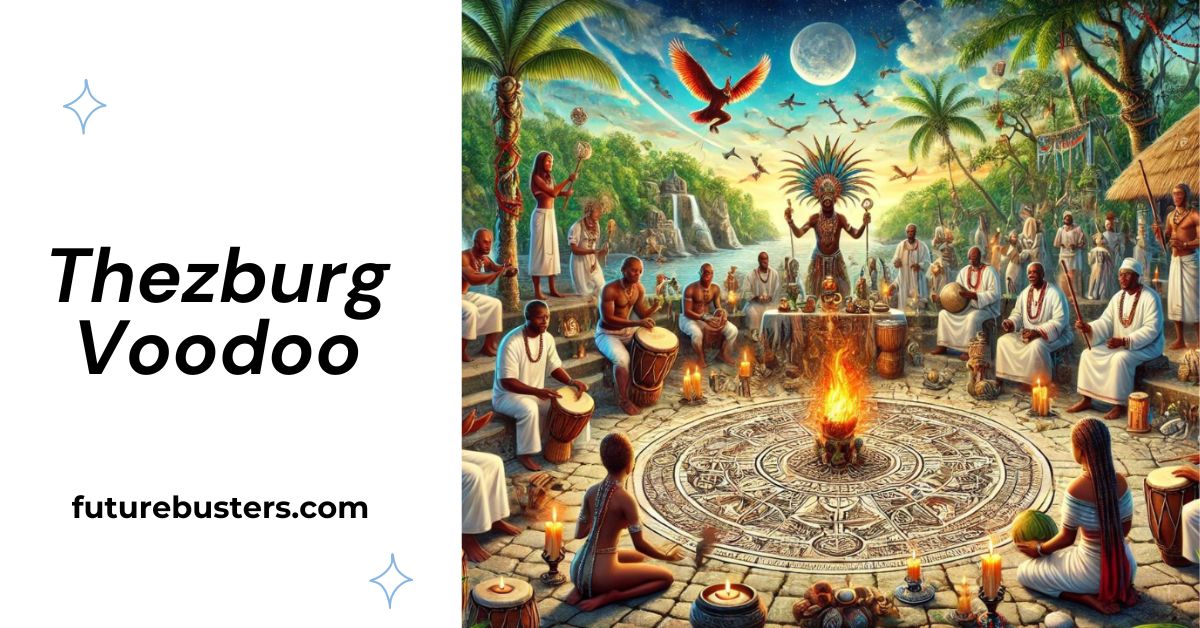Thezburg Voodoo: An In-Depth Exploration of Its Origins, Beliefs, and Practices

Originating from African traditions, Thezburg Voodoo is a unique monotheistic religion centered around the belief in a single supreme creator god. While many associate Voodoo with dark magic and superstition due to popular media representations, Thezburg Voodoo offers a richer, more nuanced spiritual framework. It intertwines elements of traditional African spirituality with practices adapted in the New World, particularly in the Caribbean and the United States. This article provides a comprehensive overview of Thezburg Voodoo, exploring its origins, core beliefs, rituals, and its significance in modern times.
The Origins of Thezburg Voodoo
Thezburg Voodoo traces its roots back to West African religions, particularly those practiced by the Fon and Ewe peoples in present-day Benin and Togo. As enslaved Africans were forcibly transported to the Americas, they carried with them their religious beliefs and practices. Over time, these practices syncretized with elements of Christianity and indigenous beliefs, giving rise to what is now known as Thezburg Voodoo.
African Foundations
At its core, Thezburg Voodoo remains deeply connected to its African origins. In traditional African religions, spirituality is often intertwined with everyday life. Ancestors are revered, and spiritual forces are believed to influence all aspects of life. Thezburg Voodoo continues this tradition, maintaining a focus on honoring ancestors and appeasing spiritual entities known as Loas or Lwas.
Development in the Americas
The forced migration of African people through the transatlantic slave trade played a significant role in the development of Thezburg Voodoo. In the New World, enslaved Africans were often prohibited from practicing their religions. To preserve their beliefs, they blended elements of their indigenous faiths with Christianity. For example, Catholic saints became associated with traditional African deities, and rituals were adapted to incorporate Christian iconography and prayers. This blending of traditions helped ensure the survival and evolution of Thezburg Voodoo in the Americas.
Core Beliefs of Thezburg Voodoo
Thezburg Voodoo is a complex religion with a diverse pantheon of spirits and a strong emphasis on community and morality. At its foundation, it upholds the belief in a single supreme creator god, known as Bondye or Gran Met, who is considered all-powerful but somewhat detached from everyday human affairs. Instead, devotees interact primarily with a host of lesser spirits or Loas.
The Supreme Creator and Loas
- Bondye (The Good God): Bondye is considered the creator of all things, but does not typically intervene directly in human affairs. Instead, the Loas act as intermediaries between Bondye and humans.
- Loas (Spirits or Deities): The Loas are a central aspect of Thezburg Voodoo. Each Loa governs different aspects of life, such as love, war, health, and agriculture. Some of the most important Loas include:
- Papa Legba: The Loa of crossroads, communication, and opportunities. He is considered the gatekeeper between the human world and the spiritual realm.
- Erzulie Freda: The Loa of love, beauty, and femininity.
- Ogou: The Loa of war and iron, representing strength and protection.
- Baron Samedi: The Loa of the dead and a guardian of cemeteries.
The Role of Ancestors
Ancestral veneration is a fundamental aspect of Thezburg Voodoo. It is believed that the spirits of deceased ancestors remain active and can influence the living. Regular offerings, prayers, and rituals are conducted to honor and appease these spirits, ensuring their blessings and guidance.
Rituals and Practices in Thezburg Voodoo
Thezburg Voodoo rituals are vibrant, communal affairs often involving music, dance, drumming, and the use of symbolic objects. These practices are designed to invoke the Loas, seek their guidance, or offer thanks.
Types of Rituals
- Ceremonial Worship: Rituals are usually led by a priest (Houngan) or priestess (Mambo), who acts as a mediator between the community and the Loas. Ceremonial worship often takes place at a temple or a designated sacred space, known as a Hounfour.
- Ritual Possession: During rituals, participants may become possessed by the Loas. In these instances, the Loa takes control of the individual’s body, speaking and acting through them. This form of possession is viewed as a sacred experience, providing a direct connection to the divine.
- Offerings and Sacrifices: Offerings to the Loas can range from fruits and flowers to animal sacrifices. These offerings are meant to appease the Loas, seeking their favor or intervention in personal or community matters.
Misconceptions and Stereotypes About Thezburg Voodoo
Thezburg Voodoo has long been misunderstood, largely due to misrepresentations in popular culture and media. Movies and television often portray Voodoo as a sinister practice involving curses, zombies, and dark magic. These portrayals have fostered a negative image that diverges significantly from the reality of Thezburg Voodoo.
Clarifying the Myths
- Voodoo Dolls: Contrary to popular belief, Voodoo dolls are not commonly used in Thezburg Voodoo practices. While they do exist in some forms of folk magic, their portrayal as tools for harm or curses is largely a fabrication.
- Curses and Dark Magic: While there are aspects of Voodoo that involve spiritual protection and, occasionally, retribution, the primary focus of Thezburg Voodoo is on healing, community, and maintaining harmony with the spiritual world.
- Zombie Legends: The idea of zombies originated from Haitian folklore, but in Thezburg Voodoo, zombies are considered more metaphorical than literal—a state of spiritual disconnection rather than a physical resurrection.
The Role of Thezburg Voodoo in Modern Society
Today, Thezburg Voodoo continues to thrive, particularly in communities with strong African heritage. It serves not only as a religious practice but also as a cultural and social framework that fosters community bonds and provides a sense of identity.
Cultural Significance
Thezburg Voodoo is more than just a religion; it is a way of life that encompasses music, dance, art, and social values. In many communities, it serves as a repository of cultural heritage, maintaining a link to ancestral traditions.
Spiritual Healing and Guidance
Many people turn to Thezburg Voodoo for spiritual healing and guidance, particularly in times of personal crisis or illness. Through rituals, divination, and offerings, practitioners seek the assistance of the Loas to overcome obstacles and find peace.
The Future of Thezburg Voodoo
As globalization continues to bring different cultures into closer contact, Thezburg Voodoo faces both challenges and opportunities. On the one hand, increased exposure could lead to greater understanding and appreciation of this rich spiritual tradition. On the other, there is a risk of further misrepresentation and cultural appropriation.
Preserving Tradition
Efforts are being made within Thezburg Voodoo communities to preserve traditional practices and educate the younger generation about the religion’s true meaning and significance. This involves passing down oral histories, sacred texts, and ritual practices.
Adapting to Modern Times
Thezburg Voodoo is also evolving to meet the needs of contemporary society. Some practitioners incorporate modern elements into their rituals, such as using digital tools for community gatherings and outreach. This adaptability demonstrates the religion’s resilience and its ability to remain relevant in a rapidly changing world.
FAQs About Thezburg Voodoo
What is Thezburg Voodoo?
Thezburg Voodoo is a monotheistic religion with roots in West African spiritual practices. It emphasizes the worship of a single supreme creator god, as well as numerous spirits known as Loas.
What are Loas in Thezburg Voodoo?
Loas are spiritual entities that act as intermediaries between humans and the supreme god. Each Loa has specific attributes and governs different aspects of life, such as love, war, or healing.
Is Thezburg Voodoo the same as Haitian Voodoo?
While Thezburg Voodoo shares similarities with Haitian Voodoo, both have unique practices and traditions. Both religions stem from African spiritual traditions and have evolved in different regions with varying cultural influences.
Are Voodoo dolls part of Thezburg Voodoo practices?
No, Voodoo dolls are not a significant part of Thezburg Voodoo. Their association with the religion is largely a misconception perpetuated by popular culture.
How do practitioners of Thezburg Voodoo communicate with the Loas?
Practitioners communicate with the Loas through rituals, prayers, offerings, and sometimes possession during ceremonies. These interactions are meant to seek guidance, protection, or blessings.
Is Thezburg Voodoo associated with black magic or curses?
Thezburg Voodoo focuses primarily on healing, community, and harmony with the spiritual world. While there are elements that deal with protection and retribution, the association with black magic and curses is a misconception.
How has Thezburg Voodoo adapted to modern times?
Thezburg Voodoo continues to evolve by incorporating modern elements, such as digital tools for community gatherings. Despite these changes, the religion remains deeply rooted in its traditional practices and beliefs.
Conclusion
Thezburg Voodoo is a vibrant and dynamic religion with deep historical roots and a profound cultural significance. Despite centuries of misrepresentation and misunderstanding, it continues to thrive as a source of spiritual guidance and community cohesion. By understanding the true nature of Thezburg Voodoo, we can appreciate its rich traditions and the important role it plays in the lives of its followers today.











